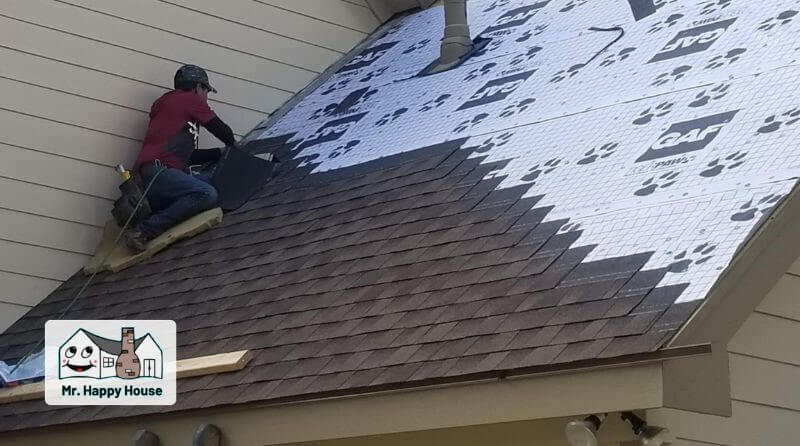
Best GAF Certified Roofers in The Woodlands, TX – Quality Roof Replacement, Gutters & Siding
Best GAF Certified Roofers in The Woodlands, TX – Quality Roof Replacement, Gutters & Siding Best GAF Certified Roofers in The Woodlands, TX – Quality

Your home’s roof is its first line of defense against the elements, and one crucial element in its protection is often hidden from view—the roof underlayment. Roof underlayment is a vital component of any roofing system, serving as a barrier that shields your home from moisture, temperature fluctuations, and other potential sources of damage.
As a homeowner or someone considering a roofing project, it’s essential to understand the significance and types of roof underlayment available. The right underlayment can significantly impact the longevity and performance of your roof, making it a decision that shouldn’t be taken lightly.
In this comprehensive guide, we will get into the world of roof underlayment, exploring the various materials at your disposal and helping you make an informed choice.
Whether you’re planning a new roof installation, a replacement, or just want to enhance your knowledge of roofing systems, this article will equip you with the knowledge you need to make the best decision for your home and budget. So, let’s dive in and explore the types of roof underlayment and determine which one is the best fit for your roofing project.
Roof underlayment is a critical but often overlooked component of your roofing system. It’s the layer of material installed between the roof deck (the structural surface) and the outer roofing material, such as shingles, tiles, or metal panels.
Understanding the role and importance of roof underlayment is fundamental to making informed decisions about your roofing project.
At its core, roof underlayment is a protective layer designed to:
Act as a Moisture Barrier: Roof underlayment acts as a barrier (at least the first barrier) against moisture infiltration. Rain, snow, and ice can be particularly damaging if they find their way into your roofing structure without a proper roof underlayment which prevents water from seeping through and causing structural damage to your roof or cause water to seep into the interior of your home.
Temperature Control: Roof underlayment helps regulate temperature fluctuations within your home. It can provide insulation against heat in the summer and trap warmth in the winter, contributing to energy efficiency.
Protection from Wind and Debris: It offers an additional layer of protection against strong winds, flying debris, and impact damage. In regions prone to severe weather, this added defense is invaluable.
Roof underlayment is like insurance for your roof.
*Speaking about insurance. Please note that your homeowners insurance may not approve of a new roof installation and may even deny coverage if they believe your roof does not have roof underlayment.*
Roof underlayment serves as a safeguard against unexpected weather events and long-term wear and tear. Here’s why it’s essential:
Leak Prevention: One of its primary functions is to prevent water leaks. Without underlayment, water can infiltrate through gaps, seams, or damaged roofing materials and cause extensive interior damage.
Longevity: Underlayment extends the lifespan of your roof by shielding it from moisture and temperature extremes, which can accelerate deterioration.
Energy Efficiency: It can contribute to energy savings by providing additional insulation and reducing the workload on your HVAC system.
Warranty Requirements: Many roofing material manufacturers require the installation of underlayment to validate their warranties. Neglecting this step could void your warranty.
In summary, roof underlayment is a crucial layer in your roofing system that protects your home from the elements, helps control temperature, and ensures the longevity of your roof. In the next section, we’ll explore the various types of materials used for roof underlayment, each with its own set of advantages and considerations.
When it comes to roof underlayment, there are various materials to choose from, each with its unique characteristics and suitability for different roofing scenarios.
Understanding the options available will help you make an informed decision regarding the underlayment material that best suits your specific needs. Here are some common types of roof underlayment materials:
Regular felt paper has been the norm for roof underlayment for decades. It is often chosen for its affordability. It provides a basic level of protection for your roof without significantly impacting your roofing project budget. During installation, regular felt paper provides a slip-resistant surface for roofers. This can enhance safety and efficiency during the roofing process.
Durability: While asphalt felt is cost-effective, it is generally not as durable as some other underlayment materials. Over time, it may be more susceptible to wear and tear, particularly in areas with frequent weather extremes.
Longevity: The lifespan of asphalt felt can vary depending on factors such as climate, installation quality, and the type of roofing material used above it. In most cases, regular felt paper doesn’t provide the same long-term protection as more advanced underlayment options.
Using Asphalt Felt Paper as a Roof Underlayment:
Budget-Friendly Projects: Asphalt felt is a suitable choice for budget-conscious roofing projects where long-term durability is not the primary concern.
Moderate Climates: It is well-suited for regions with moderate climates that do not experience extreme temperature fluctuations or heavy rainfall.
Short-Term Solution: It can be a reasonable choice for short-term solutions or temporary roofing projects where the underlayment’s longevity is less critical.
It’s important to note that while asphalt felt is a cost-effective option, it may not be the best choice for all roofing scenarios, especially those with high moisture levels, extreme weather conditions, or where long-term durability is a priority. It’s best to contact a professional roofing contractor or company who can provide guidance for you on whether asphalt felt is appropriate for your specific project or if another underlayment material would be more suitable.
Synthetic underlayment is typically made from polyethylene or polypropylene-based materials which is best known for its impact strength. Synthetic roof underlayment is also lightweight, making it easy for roofing professionals to handle and install. Its light weight can also reduce the overall load on your roof structure.
Excellent Moisture Resistance: It offers outstanding resistance to moisture, preventing water from penetrating your roof’s deck and causing damage to the structure below. This makes it particularly suitable for regions with heavy rainfall or snow.
High UV and Tear Resistance: Synthetic underlayment is known for its durability. It resists tearing during installation and is less susceptible to UV damage over time compared to some other materials.
Cons:
Synthetic underlayment is generally more expensive than traditional asphalt felt. However, many homeowners and roofing professionals view this as a worthwhile investment due to its performance benefits.
Considerations for Using Synthetic Roof Underlayment:
Synthetic underlayment is an excellent choice for areas prone to heavy rainfall, snow, or high humidity levels, as it provides exceptional moisture protection. If you’re looking for a long-lasting underlayment that can withstand harsh weather conditions and provide extended protection, synthetic underlayment is your best choice.
Roofing Material Compatibility: It is compatible with various roofing materials, including asphalt shingles, metal roofing, and tile, making it versatile for different roofing projects.
Energy Efficiency: Due to its insulating properties, synthetic underlayment can contribute to improved energy efficiency in your home by helping to maintain stable temperatures.
Professional Installation: While DIY installation is possible for some, professional installation is recommended for synthetic underlayment, as it requires proper sealing to ensure its effectiveness.
Overall, synthetic underlayment is a popular choice for modern roofing projects, offering superior moisture resistance, durability, and ease of installation. Its higher initial cost is often justified by its long-term performance benefits, making it a smart investment for homeowners looking for a reliable and efficient roofing underlayment.
Peel-and-stick membrane, also known as self-adhering underlayment, is typically made from modified bitumen or rubberized asphalt materials.Peel-and-stick membranes are known for their ease of installation. They come with a built-in adhesive backing that allows them to adhere securely to the roof deck without the need for additional fasteners.
Excellent for Flat or Low-Slope Roofs: Peel-and-stick membranes are particularly well-suited for flat or low-slope roofs, where water can pool and moisture resistance is crucial.
Considerations for Using Peel-and-Stick Membrane:
Flat or Low-Slope Roofs: These underlayments are an excellent choice for roofs with minimal pitch, as they offer exceptional water resistance in areas where water may pool.
Peel and stick on membranes are also recommended to be installed in areas that are prone to water buildup and can depend on the slope and the structure of your roof, which is why you must contact a professional roofer for a full answer on this specific topic.
Proper installation and ongoing maintenance of your roof underlayment are essential to ensure its effectiveness and the long-term performance of your roofing system. In this section, we’ll provide you with some valuable tips for both installing and maintaining your roof underlayment:
While some underlayment materials are DIY-friendly, it’s often best to hire a professional roofing contractor for installation. They have the experience and knowledge to ensure a proper and secure installation. Here are some tips on roof underlayment installation to point you in the right direction:
Surface Preparation: Ensure that the roof deck is clean, dry, and free of debris before installing the underlayment. Any imperfections or debris can compromise the underlayment’s effectiveness.
Overlap Seams: Properly overlap the seams of the underlayment material according to the manufacturer’s guidelines. This helps create a continuous moisture barrier.
Adhesive Application: If you’re using self-adhering underlayment, follow the manufacturer’s instructions for applying adhesive and sealing seams. Pay close attention to temperature requirements for proper adhesion.
Ventilation Considerations: Make sure your roofing system includes adequate ventilation. Proper ventilation helps prevent moisture buildup in the attic, which can affect the underlayment’s performance.
Periodically inspect your roof and underlayment for signs of damage or wear. Look for tears, punctures, or areas where the underlayment may have lifted. Keep your gutters and downspouts clean to ensure proper drainage of rainwater. Clogged gutters can lead to water overflow, potentially compromising the underlayment.
Trim Overhanging Branches: Trim any overhanging tree branches that may scratch or damage the roof surface and underlayment during storms.
Check Flashing and Seals: Inspect flashing around chimneys, vents, and other roof penetrations for signs of deterioration or damage. Ensure that seals are intact to prevent leaks.
Address Repairs Promptly: If you notice any issues with your roof or underlayment, address them promptly. Delaying repairs can lead to more significant problems and potentially costly damage.
By following these installation and maintenance tips, you can help ensure that your roof underlayment continues to provide effective protection for your home over the long term. Regular inspections and proactive maintenance can extend the life of your roofing system and prevent potential issues down the road.
In this section, we’ll address some common questions and concerns related to roof underlayment. These frequently asked questions can help you gain a deeper understanding of this crucial roofing component:
Roof underlayment is generally recommended for most types of roofing, but the necessity can vary depending on factors like climate, roofing material, and local building codes. For most cases, roof underlayment is absolutely necessary to ensure your roof lasts for many years to come.
The feasibility of a DIY installation depends on the type of underlayment and your roofing experience. While some materials are DIY-friendly, others require professional expertise and a trained roofing installation team to ensure proper adhesion and sealing.
It’s advisable to hire a qualified roofing contractor to install roof underlayment during a roof replacement project, attempting to do this by yourself on your roof can be very dangerous and can take a considerable amount of time.
While it may not be possible to directly check your roof underlayment without tearing off your shingles, you can still get a good idea on the condition of it with a regular roof inspection. Look for signs of lifted, torn, and degraded shingles. Promptly address any issues you discover.
It is not recommended to reuse old roof underlayment. Over time, underlayment can degrade and lose its effectiveness. Installing new underlayment is the only way to ensure a proper roof installation.
Both synthetic underlayment and asphalt felt have their advantages. Synthetic roof underlayment is known for its durability and moisture resistance, making it a popular choice for modern roofing projects. However, the choice depends on your specific needs and budget.
While it’s technically possible to install a new roof without underlayment, it’s strongly discouraged and not recommended. Roof underlayment is a critical component for protecting your home from moisture and temperature fluctuations. Neglecting it can lead to costly repairs in the long run (or short run shall we say).
Roof underlayment can contribute to energy efficiency by helping to regulate temperature fluctuations in your attic space. Some underlayment materials provide additional insulation, reducing the workload on your HVAC system and potentially lowering energy bills.
During tear off of a roof, the roof underlayment at times can stick to the roofing shingles themselves along with nail holes and more factors, making it a very difficult task to keep the old roofing shingles in good condition during the roof tear off process. If you want to upgrade your roof, the proper way to ensure your roof is prone to leaks and the elements in the long run is to replace the entire roof.
In conclusion, selecting the right roof underlayment is a critical decision when it comes to your roofing project. It plays a vital role in protecting your home from the elements, maintaining energy efficiency, and ensuring the longevity of your roofing system. To recap the key points discussed in this article:
Understanding Roof Underlayment: We began by explaining the fundamental role of roof underlayment as a moisture barrier, temperature regulator, and protector of your roofing structure.
Types of Roof Underlayment Materials: We explored various underlayment materials, including traditional felt paper and synthetic underlayment, highlighting the pros and cons of each underlayment.
Choosing the Right Underlayment: We emphasized the importance of considering factors such as climate, roofing material, budget, and more when selecting the appropriate underlayment for your roofing project.
Installation and Maintenance Tips: We provided valuable tips for the proper installation and ongoing maintenance of your underlayment to ensure its effectiveness and longevity.
Cost Considerations: We discussed how the choice of underlayment can impact your overall roofing project budget and why it’s essential to balance cost with performance.
Frequently Asked Questions (FAQs): We addressed common questions and concerns to enhance your understanding of roof underlayment and help you make informed decisions.
As you embark on your roofing project, keep in mind that the right choice of underlayment can contribute to the durability, efficiency, and overall performance of your roof for years to come. We encourage you to contact a professional roofer for a better solution to your roofing needs as every roof has their slight differences.
By investing time and attention into selecting and maintaining the appropriate roof underlayment, you can ensure that your home remains protected and comfortable, regardless of the weather conditions outside.
Our Services:












Schedule an Estimate Today!

Best GAF Certified Roofers in The Woodlands, TX – Quality Roof Replacement, Gutters & Siding
Best GAF Certified Roofers in The Woodlands, TX – Quality Roof Replacement, Gutters & Siding Best GAF Certified Roofers in The Woodlands, TX – Quality

Are Gutters Part of the Roofing System?
Are Gutters Part of the Roofing System? Are Gutters Part of the Roofing System? When it comes to home maintenance, gutters often seem like a

Why James Hardie is The Best Option for Home Siding
Why James Hardie is The Best Option for Home Siding Why James Hardie is The Best Option for Home Siding James Hardie stands out whether











